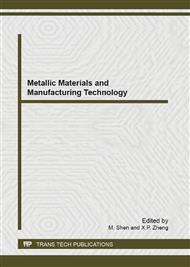p.175
p.180
p.185
p.190
p.194
p.200
p.204
p.208
p.212
Influence of Cutting Conditions on the Width of Adiabatic Shear Bands: An Investigation Using Finite Element Simulation
Abstract:
In this paper, a novel model combining the microstructure prediction model and a modified constitutive model of the Johnson-Cook (JC) model was developed and embedded into FEM software via the user subroutine. The chip formation and microstructure evolution in high speed cutting of Ti-6Al-4V alloy were simulated. The results indicated that dynamic recrystallization mainly happened in adiabatic shear bands (ASBs), where the grain size had a big decline. Then FEM simulations were carried out to investigate the effect of cutting velocity, uncut chip thickness, and the rake angle on the ASBs width of the serrated chips. It can be concluded that the width of ASB increases with the increasing of cutting depth and cutting velocity, and decreases with the increasing of rake angle of the tool.
Info:
Periodical:
Pages:
194-199
Citation:
Online since:
September 2013
Authors:
Price:
Сopyright:
© 2013 Trans Tech Publications Ltd. All Rights Reserved
Share:
Citation:


